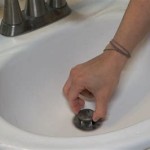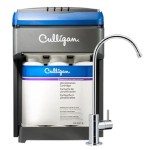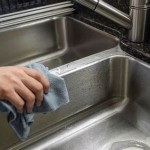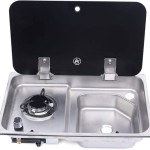Best Things to Clean a Stainless Steel Sink
Stainless steel sinks are a popular choice for kitchens due to their durability, sleek appearance, and resistance to rust and corrosion. However, maintaining their shine and cleanliness requires regular attention and the use of appropriate cleaning methods. This article explores the most effective approaches and substances for cleaning stainless steel sinks, ensuring they remain hygienic and visually appealing for years to come.
Understanding the composition of stainless steel is crucial for choosing the right cleaning agents. Stainless steel is an alloy primarily composed of iron, chromium, and other metals. The chromium content is key, as it reacts with oxygen to form a thin, protective layer that prevents rust. Harsh chemicals and abrasive cleaners can damage this protective layer, leading to dullness, scratches, and even corrosion. Therefore, selecting cleaning products that are gentle yet effective is paramount for the longevity of your sink.
Key Point 1: Daily Maintenance for Stainless Steel Sinks
Daily maintenance is the cornerstone of keeping your stainless steel sink clean and preventing the buildup of stains and grime. This involves rinsing the sink thoroughly after each use and wiping it down with a soft cloth or sponge. This simple step removes food particles, soap scum, and water spots before they have a chance to dry and become difficult to remove.
A mild dish soap is an excellent choice for daily cleaning. Its gentle formulation effectively cuts through grease and grime without damaging the stainless steel surface. Add a few drops of dish soap to a sponge or cloth and wipe down the entire sink, paying particular attention to areas around the drain and faucet where residue tends to accumulate. Rinse thoroughly with warm water and dry with a clean, microfiber cloth to prevent water spots.
The direction of the grain in the stainless steel should also be considered during cleaning. Most stainless steel sinks have a visible grain pattern. Wiping along the grain, rather than against it, helps to prevent scratches and ensures a more even clean. This subtle technique can significantly improve the overall appearance of your sink over time.
Preventing hard water spots is another key aspect of daily maintenance. Hard water contains minerals like calcium and magnesium, which can leave unsightly spots on stainless steel surfaces. Drying the sink immediately after each use is the most effective way to prevent these spots. If hard water spots do appear, a mild solution of vinegar and water can often remove them.
Avoid leaving standing water in the sink for extended periods. Standing water can contribute to the formation of water spots and mineral deposits. Regularly emptying the sink and ensuring proper drainage will help to maintain its cleanliness and prevent the accumulation of residue.
Key Point 2: Effective Cleaning Agents for Deeper Cleaning
While daily maintenance is essential, a deeper cleaning is necessary periodically to remove more stubborn stains and grime. Several effective cleaning agents can be used to achieve this, each with its own advantages and considerations.
Baking soda is a versatile and gentle abrasive that can be used to tackle a variety of stains on stainless steel. Its mild alkalinity helps to loosen grime and remove stubborn spots without scratching the surface. To use baking soda, sprinkle a small amount onto a damp sponge or cloth and gently scrub the affected areas. Rinse thoroughly with water and dry with a clean cloth.
White vinegar is another excellent cleaning agent for stainless steel sinks. Its acidic properties help to dissolve mineral deposits and soap scum. Dilute white vinegar with an equal amount of water and spray the solution onto the sink surface. Allow it to sit for a few minutes before scrubbing with a sponge or cloth. Rinse thoroughly and dry with a clean cloth. The vinegar smell will dissipate quickly.
For particularly stubborn stains, a paste made from baking soda and water can be applied to the affected area. Allow the paste to sit for 15-20 minutes before scrubbing gently with a sponge or cloth. This method is particularly effective for removing burnt-on food residue or rust stains. Rinse thoroughly and dry with a clean cloth.
Commercial stainless steel cleaners are also available and can be effective in removing stains and polishing the sink. When using these products, it is important to follow the manufacturer's instructions carefully. Choose a cleaner specifically formulated for stainless steel and avoid those containing harsh chemicals or abrasive particles. Test the cleaner on a small, inconspicuous area of the sink before applying it to the entire surface.
Lemon juice is a natural alternative for removing hard water spots and brightening the sink. Its acidity helps to dissolve mineral deposits and leave a fresh scent. Simply apply lemon juice to the affected areas, allow it to sit for a few minutes, and then scrub gently with a sponge or cloth. Rinse thoroughly and dry with a clean cloth.
Key Point 3: Substances to Avoid When Cleaning Stainless Steel
Certain cleaning products and tools can damage stainless steel sinks and should be avoided. Understanding which substances to avoid is just as important as knowing which ones to use.
Abrasive cleaners, such as scouring powders and steel wool, can scratch the stainless steel surface, leading to dullness and potential corrosion. These products contain harsh particles that can remove the protective chromium oxide layer, making the sink more susceptible to damage. Always opt for gentle, non-abrasive cleaning methods.
Chlorine bleach can also damage stainless steel. While it may seem like an effective disinfectant, bleach can cause pitting and discoloration. Avoid using bleach-based cleaners on your stainless steel sink. If disinfection is necessary, consider using a diluted solution of hydrogen peroxide or a commercial stainless steel disinfectant.
Avoid using steel brushes or scouring pads, as these can leave scratches on the surface. Opt for soft cloths, sponges, or brushes with nylon bristles to clean your stainless steel sink. These materials are gentle enough to remove grime without causing damage.
Harsh chemicals, such as oven cleaners and drain cleaners, should never be used on stainless steel sinks. These products contain corrosive substances that can damage the finish and lead to irreversible damage. Always use cleaning products specifically designed for stainless steel or opt for natural alternatives like baking soda and vinegar.
Leaving rubber mats or wet sponges in the sink for extended periods can trap moisture and create a breeding ground for bacteria. This can also lead to discoloration and staining of the stainless steel. Regularly clean and dry rubber mats and sponges, and avoid leaving them in the sink overnight.
Salt can also be corrosive to stainless steel if left in contact with the surface for prolonged periods. Always rinse the sink thoroughly after using salt to prepare food or clean dishes. This will prevent the salt from damaging the protective chromium oxide layer.
By adhering to these guidelines and utilizing the recommended cleaning methods, individuals can effectively maintain the cleanliness and appearance of their stainless steel sinks, ensuring their longevity and hygiene for years to come.

The Secret To Cleaning Stainless Steel Sinks Like A Pro

9 Best Stainless Steel Cleaners Of 2024 Tested By Experts

How To Clean A Stainless Steel Sink And Make It Shine Simple 3 Step Solution With Ingredients Found Around Your Home The Thrifty Couple

How To Clean And Shine Your Stainless Steel Sink With Flour

How To Clean A Stainless Steel Sink Blanco

Best Way To Clean Stainless Steel Sink Cosmos Surfaces

Clean Up A Stainless Steel Sink What Works The Best

How To Clean A Stainless Steel Sink So It Sparkles Taskrabbit Blog

Stainless Steel Sink Care

The Easy Way To Clean A Stainless Steel Sink Young House Love







